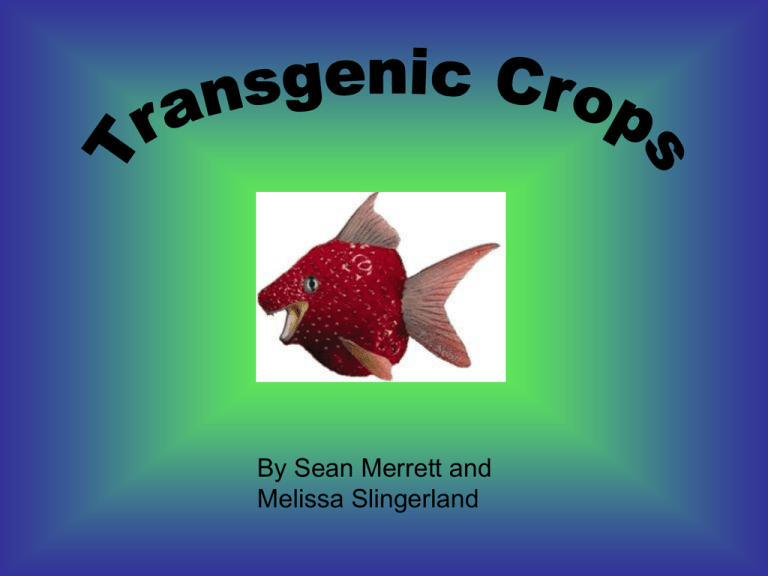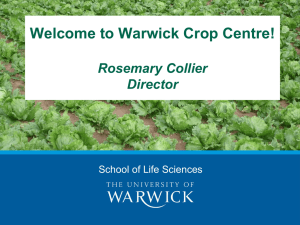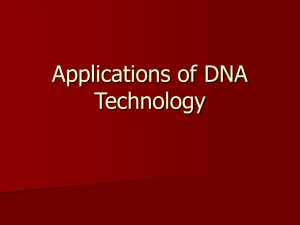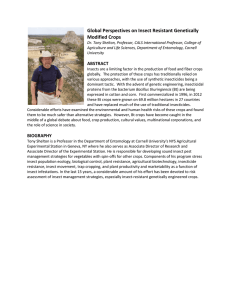By Sean Merrett and Melissa Slingerland
advertisement

By Sean Merrett and Melissa Slingerland • are also known as genetically modified or GM crops • A transgenic crop plant contains a gene or genes which have been artificially inserted instead of a plant acquiring them through pollination. •The inserted gene sequence (transgene) may come from another unrelated plant, or completely different species. • Throughout history all crops have been genetically modified from their original wild state by domestication, selection, and control of breeding over long periods of time. • Genetic engineering speeds up the process and increases the variety of genes which can be inserted into a particular plant. An Overview of the Crop Genetic Engineering cycle This was the first “genetically modified” food approved by the FDA in 1994. It was eventually pulled off the market in 1997 because of the controversy surrounding it. Questions arose about it’s effects on human health, the environment, potential gene transfer, and the creation of “Frankenfood”. Flavr Savr The Flavr Savr tomato ripens on the vine – resulting in fuller flavour. It is modified so that it remains firm after harvesting. Traditional The traditional tomato must be harvested while it is still green and firm so that it is not crushed on the way to the supermarket. The traditional tomato is sprayed with ethylene after shipping to induce ripening. Ripe and Increased Flavour. Ripe but decreased Flavour. Worldwide production area of transgenic crops and traits (source: Science 286:1663, 1999). Crop Area planted in 1999 (millions of acres) Soybean 53.4 Corn 27.4 Cotton 9.1 Canola 8.4 Potato 0.3 Squash 0.3 Papaya 0.3 Trait Herbicide tolerance 69.4 Bt insect resistance 22.0 Bt + herbicide tolerance 7.2 Virus resistance 0.3 As of 2003, the Canadian government has approved over 60 genetically modified foods for sale in Canada. Some of these include: insect resistant corn herbicide tolerant soybean, sugarbeet, corn, and rice virus resistant squash insect and virus resistant potato Control Mechanisms used by Seed Companies • Technology Protection System, also known as the “terminator”, incorporates a trait that kills developing plant embryo’s so seeds cannot be saved and replanted in subsequent years • “Traitor”, also known as Trait-specific Genetic Use Restriction Technology incorporates a control mechanism that requires yearly applications of a propriety chemical to activate desirable traits in the crop • the farmer can save and replant seeds but cannot gain the benefits of the controlled traits unless he pays for the activating chemical each year • improved nutritional quality • increased crop yield • insect resistance • disease resistance • herbicide resistance • salt tolerance • biopharmaceuticals Weed-infested soybean plot (left) and Roundup Ready® soybeans after Roundup treatment. Source: Monsanto • saving valuable topsoil • ability to grow plants in harsh environments •Damage to human health •allergies •horizontal transfer and antibiotic resistance •eating foreign DNA •changed nutrient levels •Damage to the natural environment •crop-to-weed gene flow •leakage of GM proteins into soil •reductions in pesticide spraying: are they real? •Disruption of current practices of farming and food production in developed countries •crop-to-crop gene flow •Disruption of traditional practices and economies in less developed countries • Lack of research on consequences of transgenic crops • disruption of natural ecosystems • introduction of diseases • creation of biological weapons • ethical dilemmas • ie. Could human genes be inserted into new crops? http://dragon.zoo.utoronto.ca/~jlm-gmf/T0501D/introduction.html http://www.colostate.edu/programs/lifesciences/TransgenicCrops/animation.html# http://users.rcn.com/jkimball.ma.ultranet/BiologyPages/T/TransgenicPlants.html#Terminator_Genes http://images.google.ca/imgres?imgurl=www.carascissoria.com/images/poli/frankenfood.jpg&imgrefurl=http://www. carascissoria.com/general/singles/6173.htm&h=310&w=234&sz=33&tbnid=4aYYWnTCTGMJ:&tbnh=111&tbnw= 84&start=2&prev=/images%3Fq%3Dfrankenfood%2Bpictures%26hl%3Den%26lr%3D%26ie%3DUTF-8%26sa% 3DN http://www.inspection.gc.ca/english/sci/biotech/safsal/gmoogme.shtml http://www.greenpeace.ca/e/campaign/gmo/backgrnd/index.php Whitney, E.N. and Rolfes, S.R. (2002). Understanding Nutrition (9th edition). Belmont, CA: Wadsworth/Thomson Learning.





